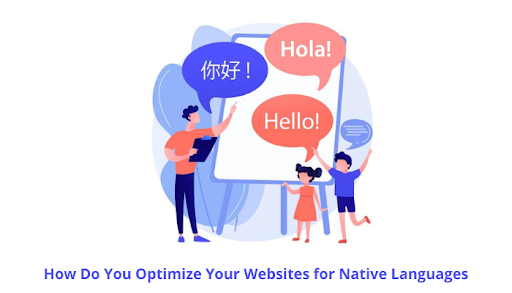Website optimizing is indeed necessary to grow a business as it is all about improving a Website optimizing is indeed necessary to grow a business as it is all about improving a website’s performance, but optimizing a website for a native language will give your website a chance to reach more audiences and perform better internationally. This concept is known as multilingual SEO, which is often overlooked by many website owners resulting in losing millions of worldwide traffic. Like other SEO strategies, multilingual SEO is an effective way to optimize your website. Many Internet Marketing Company emphasizes optimizing the websites for native languages so that you don’t have to make separate content for the language you are targeting.
So, if you want your website to reach a broad audience and help your brand to introduce globally, make sure your website content is not only visible to a speaking community, but it is also to the people speaking other languages.
What Is Multilingual SEO?
As already mentioned above, multilingual SEO is about optimizing your site for native speakers in countries other than your own. For instance, if your target audience is located in the United States, you will find that not all of them are native English speakers. So, it is necessary to use multilingual search engine optimization to reach all. Though most website owners rely on Google translate so that non-English speakers can use it to translate the result of a Google search and your website content, using a dedicated multilingual SEO strategy will help you get a far better result. If you are interested in Melbourne SEO agencies head over to EngineRoom.
This article will show you how to optimize your websites for native languages:
Tips to Set Up Your SEO for Different Languages & Countries:
Now, let’s get a clear idea of how SEO experts optimize a website for native languages.
1. Use Dedicated URLs:
The main fear with multilingual sites is duplicate content. Google always recommends using such URLs that include a language indicator. The role of the indicator is to enable search engines and users to identify the language from the URL alone. For example, if your original page URL is,business.com, while the French version could be www.business.com/fr/ and similarly the German version will be www.business.com/de/ and so on. Simply put, defining your URL parameters is an important step to making sure that your website is SEO compatible. You have three choices of using dedicated Country Code Top Level Domains and subdomains on your sites such as Top-level domain, subdomain, and subdirectory.
2. Apply hreflang Tags:
Hreflang is an HTML tag attribute that applies to websites having the same content but providing to different languages or countries. The primary role of these tags is to identify the languages of a particular site by search engines. Each hreflang value must involve a language code or a country code or both of them separated by a hyphen. Again, you can also use the alternate tags along with the hreflang. These tags will help you show the most appropriate version of your website to the users who are searching from a specific country or in a particular language.
3. Avoid Using Multiple Languages on One Page:
If you use multiple languages on one page, it will give a poor impression to the users resulting in reducing the user experience. So, experts always recommend maintaining one language for a single page. Make sure the main content and the content of the navigated page are in the same language. It will allow users to understand the other contents of your websites. Again, it is also not a good idea to translate side-by-side as Google recommends avoiding this thing. But if you want to do this, you must incorporate hreflang tags as many times as it needs with the help of a Multilingual Paid Campaign.
4. Use Translated Version of Metadata:
It is good to incorporate the translated version of Meta Title and Meta Description. It will help you to increase the content visibility and understanding for the global audience. Though there is Google Translator to help you translate automatically, it is better to go for manual translation to get a more accurate result.
5. Consider Website Loading Speed:
Though website loading speed is not directly related to optimizing your website for native languages, still it plays a crucial role when it comes to Standard SEO of Your Website. Research shows that more than 40% of the consumers leave a site that takes more than 3 seconds to load. It simply means that the time your website takes to load affects the bounce rate and ranking of a website in the search engines.
6. Make Sure Your Website is Optimized for Everyone:
There are several important things that you need to consider while optimizing your website for native languages, one such factor is to create a plan and strategy to optimize your website for everyone. To make it possible, you need to research the audience, their native languages, habits, and needs and develop a specific solution to translate your content and metadata for your target customers and locations.
Conclusion:
So, there is no denying the fact that a Multilingual SEO Campaign is indeed necessary to boost your website ranking and improve the overall user experience. But make sure the digital marketing company you hire can effectively do these tasks and help you to start your journey towards better search engine rankings, high-quality website traffic, increased ROI, and many more.
FAQs:
Why it is important to optimize your website for native languages?
A multilingual website is tailored for different audiences that will help you expand your reach to a much wider audience.
How does a multilingual site help SEO?
Making your site available in multiple languages can help you improve your Search Engine Optimization efforts.
How much does it cost to optimize your website for native languages?
It largely depends on the specific language. Some languages like simplified Chinese and Spanish are less expensive than those of Japanese or German.


Thank you, your article surprised me, there is such an excellent point of view. Thank you for sharing, I learned a lot. https://accounts.binance.com/register-person?ref=P9L9FQKY
Your article helped me a lot, is there any more related content? Thanks!
Can you be more specific about the content of your article? After reading it, I still have some doubts. Hope you can help me.